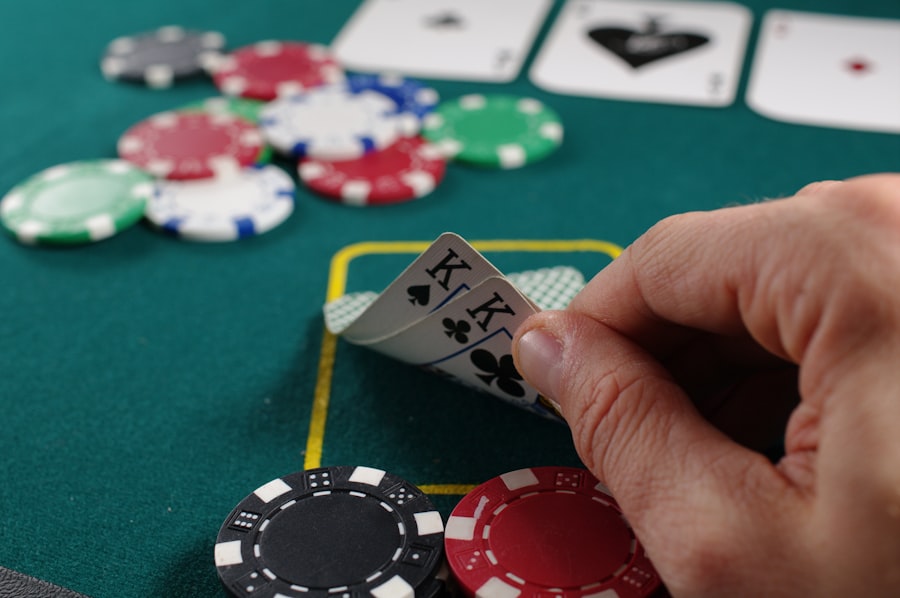Download links
How to install Mastering the Art of Poker: Strategies for Success APK?
1. Tap the downloaded Mastering the Art of Poker: Strategies for Success APK file.
2. Touch install.
3. Follow the steps on the screen.
Description
Poker is a card game that combines elements of chance and skill, making it a unique and engaging pastime. At its core, the game revolves around betting and individual play, where players aim to win chips or money by either having the best hand or convincing others to fold. The most popular variant, Texas Hold’em, involves each player being dealt two private cards and using five community cards to create the best possible five-card hand.
Understanding the hierarchy of poker hands is crucial; from the high card to the royal flush, each combination has its own value and significance in determining the winner. The rules of poker can vary significantly between different variants, but the fundamental principles remain consistent. Players must learn to navigate the betting rounds, which typically include options to check, bet, call, raise, or fold.
The strategic depth of poker lies in the decisions made during these rounds, where players must weigh their hand strength against their opponents’ potential holdings. Familiarity with terms such as “pot odds,” “implied odds,” and “position” is essential for any aspiring player. Position refers to where a player sits at the table in relation to the dealer, which can greatly influence their strategy and decision-making process throughout the game.
Key Takeaways
- Poker is a game of skill and strategy, not just luck
- A winning mindset involves discipline, patience, and emotional control
- Bluffing is a crucial part of poker, but it should be used strategically
- Analyzing your opponents’ behavior and patterns can give you an edge
- Proper bankroll management is essential for long-term success in poker
Developing a Winning Mindset
A winning mindset in poker is not merely about understanding the rules or strategies; it encompasses a psychological approach that can significantly impact performance. Successful players cultivate resilience and emotional control, allowing them to navigate the ups and downs inherent in the game. The ability to remain calm under pressure is vital, as poker can be a rollercoaster of emotions.
Players often face situations where they must make critical decisions with limited information, and maintaining composure can lead to more rational choices rather than impulsive reactions driven by frustration or excitement. Moreover, a winning mindset involves embracing a growth-oriented perspective. This means viewing losses not as failures but as opportunities for learning and improvement.
Analyzing past hands, reflecting on mistakes, and seeking feedback from more experienced players can foster a deeper understanding of one’s own playstyle and areas for development. Additionally, setting realistic goals—whether it’s improving specific skills or achieving a certain level of success in tournaments—can help maintain motivation and focus. The journey of becoming a proficient poker player is ongoing, and those who approach it with curiosity and determination are more likely to thrive.
Mastering the Art of Bluffing

Bluffing is one of the most intriguing aspects of poker, often regarded as an art form that separates novice players from seasoned professionals.
Successful bluffing requires a keen understanding of both one’s own table image and the tendencies of opponents. For instance, if a player has been consistently aggressive throughout a session, their bluffs may be less credible; conversely, a player who has been playing conservatively may find their bluffs more believable. Timing and context are critical when executing a bluff. A well-timed bluff can turn the tide of a hand, especially when executed in late position or against players who are likely to fold weaker hands. However, it’s essential to recognize that not all situations warrant a bluff; understanding when to apply pressure and when to back off is crucial.
Additionally, players should be aware of their own body language and betting patterns, as these can inadvertently reveal intentions. The most effective bluffs often come from a place of authenticity—when players can seamlessly integrate their bluffs into their overall strategy without drawing undue attention.
Analyzing Your Opponents
| Opponent | Strengths | Weaknesses | Strategies |
|---|---|---|---|
| Opponent 1 | Strong defense, good at counter-attacks | Weaker in midfield, prone to set pieces | Focus on dominating midfield, exploit set pieces |
| Opponent 2 | Fast wingers, good at pressing | Vulnerable in central defense, lack of creativity in attack | Exploit central defense, use quick passing to bypass pressing |
| Opponent 3 | Physicality, strong in aerial duels | Slow full-backs, lack of pace in transition | Utilize quick transitions, exploit full-backs with pace |
The ability to analyze opponents is a cornerstone of successful poker play. Each player at the table brings their own unique style, tendencies, and psychological quirks that can be exploited for strategic advantage. Observing how opponents react in various situations—such as their betting patterns, timing, and body language—can provide invaluable insights into their potential holdings.
For example, a player who consistently bets aggressively may be perceived as strong, while one who frequently checks might be seen as weak or indecisive. Categorizing opponents into different archetypes can also aid in developing effective strategies against them. Common classifications include “tight-aggressive” players who play fewer hands but bet aggressively when they do, and “loose-passive” players who enter many pots but tend to call rather than raise.
By identifying these patterns, players can tailor their approaches accordingly—exploiting weaknesses in passive players while being cautious against aggressive ones. Furthermore, maintaining an adaptable mindset allows players to adjust their strategies as they gather more information about their opponents throughout the game.
Managing Your Bankroll
Effective bankroll management is essential for long-term success in poker. It involves setting aside a specific amount of money dedicated solely to playing poker and ensuring that this amount is appropriate for one’s skill level and playing style. A common guideline is to have at least 20-30 buy-ins for cash games or 50-100 buy-ins for tournaments.
This buffer helps mitigate the risks associated with variance—the natural fluctuations in results that can occur over time due to chance. In addition to setting limits on buy-ins, players should also establish clear guidelines for when to move up or down in stakes based on their performance and comfort level. For instance, if a player consistently loses at a particular level, it may be wise to step down until they regain confidence and skill before attempting higher stakes again.
Conversely, if they experience success over an extended period, moving up can provide new challenges and opportunities for growth. Ultimately, disciplined bankroll management not only protects players from going broke but also fosters a healthier relationship with the game.
Practicing and Improving Your Skills

Continuous practice is vital for honing poker skills and achieving mastery over time. Engaging in regular play—whether through online platforms or live games—allows players to apply theoretical knowledge in real-world scenarios. However, simply playing without reflection may not lead to significant improvement; thus, incorporating analysis into practice sessions is crucial.
Reviewing hands after sessions using tools like hand history reviews or software can help identify mistakes and areas for enhancement. Additionally, seeking out educational resources such as books, videos, or coaching can accelerate skill development. Many successful players share their insights through various mediums, providing valuable lessons on strategy, psychology, and game theory.
Participating in forums or discussion groups can also facilitate knowledge exchange among peers, allowing players to learn from each other’s experiences and perspectives. By committing to ongoing practice and education, players can steadily refine their skills and adapt to the ever-evolving landscape of poker strategy. In conclusion, mastering poker requires a multifaceted approach that encompasses understanding the game’s fundamentals, developing a resilient mindset, honing bluffing techniques, analyzing opponents effectively, managing bankrolls wisely, and committing to continuous practice and improvement.
Each aspect contributes to building a comprehensive skill set that enhances overall performance at the tables. As players invest time and effort into these areas, they position themselves for greater success in this captivating game of strategy and chance.
If you’re interested in mastering online chess and cards, you may also want to check out this article on the latest fishing technology with TG777. The article discusses how TG777 is revolutionizing the fishing industry with their innovative tools and techniques. With TG777’s cutting-edge technology, anglers can improve their fishing skills and increase their chances of catching more fish. To read more about this exciting development, visit here.
FAQs
What is poker?
Poker is a popular card game that involves betting and strategy. Players compete to have the best hand of cards or to bluff their opponents into folding.
How is poker played?
Poker is typically played with a standard 52-card deck and can be played in a variety of different formats, including Texas Hold’em, Omaha, and Seven-Card Stud. Players place bets based on the strength of their hand, and the player with the best hand at the end of the game wins the pot.
What are the basic rules of poker?
The basic rules of poker involve players being dealt a hand of cards, placing bets, and then revealing their hands to determine the winner. The specific rules can vary depending on the variant of poker being played.
Is poker a game of skill or luck?
Poker is a game that involves both skill and luck. While luck plays a role in the cards that are dealt, skillful players can use strategy, psychology, and mathematical calculations to gain an advantage over their opponents.
Where is poker commonly played?
Poker is commonly played in casinos, card rooms, and private homes. It is also popular in online poker rooms, where players can compete against each other over the internet.
What are the different variations of poker?
Some popular variations of poker include Texas Hold’em, Omaha, Seven-Card Stud, and Five-Card Draw. Each variant has its own unique rules and strategies.
Is poker legal?
The legality of poker varies depending on the jurisdiction. In many places, poker is legal and regulated, while in others it may be restricted or prohibited. It is important to be aware of the laws and regulations regarding poker in your area.





